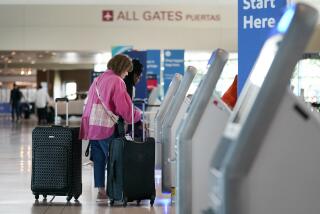The $2 airfare is a foreign concept
- Share via
Are you Internet-savvy, smart about geography and self-sufficient? Are you looking to go places? Oh — and are you really cheap?
Have I got an airline for you. Actually, several dozen. They’re low-cost regional carriers that fly within Europe and Asia, peddling seats for pocket change.
Tickets can be so inexpensive on the Dublin-based Irish carrier Ryanair, for instance, that it’s nearly a “no-fare carrier,” said industry expert Ron Kuhlmann.
Kuhlmann, vice president of Oakland-based Unisys R2A, an airline consulting firm, said he spent about $1.85 (plus tax) one way for some Ryanair flights last year. Thousands of other travelers did the same.
Among them was Lori Morrow, a Minneapolis office worker who spent less than $150 total, including taxes, to fly Ryanair from London to Bologna, Italy, then from Venice, Italy, to Dublin and Dublin back to London.
“Unbelievable,” she said.
The U.S. dollar may be down worldwide, but it sprouts wings on the right airline. Tourists can take advantage of a bevy of regional low-cost carriers — more than 50 in Europe and more than a dozen in Asia, where the trend caught on about four years ago.
What’s the catch? Actually, there are several.
Budget airlines, especially in Europe, often fly into tiny, distant airports, far from city centers. You’ll typically need to book online in a foreign currency. Tickets are usually nonrefundable. Baggage weight restrictions can be draconian. Expect to collect and schlep your bags between connecting flights.
“If you’re going to take the bargain carriers,” advises traveler Morrow, who visits Europe about twice a year, “you have to do your research and know where you’re going.”
Start by thinking seriously about your itinerary.
Budget flights work best for longer trips, such as those between countries. For short intercity trips of fewer than three hours, a train may be faster and cost about the same — or less if you’re traveling on a European rail pass priced in U.S. dollars.
Because their tickets are usually priced one way, budget airlines work especially well if you’re using one city as a hub for forays to other cities in a region.
But if you’re flying an international airline between the U.S. and a European or Asian city, and you plan to visit only one other city on the trip, using a local budget airline may cost you more than adding a stop to your long-haul itinerary.
I figured I’d save last year by flying round trip from LAX to Singapore on Singapore Airlines, then using a low-cost carrier for a $93 round-trip jaunt to and from Bangkok, Thailand. It sounded so cheap. But when I priced the trip, I saw that Singapore Airlines would throw in a Bangkok stopover for just $74 more than it was charging for the LAX-Singapore ticket alone. (These fares may no longer be available.)
Another reason to stay with your long-haul carrier in this situation is the connection issue. Budget airlines’ contracts typically disavow responsibility for getting you and your luggage onto a connecting flight.
Patrick Lohan, of Orlando, Fla., a communications company executive and a frequent traveler, said he ran into this problem when he booked $500 worth of Dublin-to-Prague tickets for himself and three friends on Smart Wings, a low-cost carrier based in the Czech Republic.
Smart Wings canceled the flights and, he said, at first declined to reimburse him, insisting that he just pick different flight dates. That wasn’t practical because the four travelers had bought $2,500 in nonrefundable transatlantic fares from Delta for their trip. Smart Wings finally relented, Lohan said, and refunded the fares.
Here are other tips to keep on your budget radar when flying in Europe and Asia:
Do the math: Make sure you know how much you’re being charged. The initial fare displayed online may not be the total; taxes and fuel surcharges can add $100 or more.
Major competition: Shop the major carriers too. They may match or beat low-cost competitors’ fares on certain routes.
Where do you land? Find out where the airports are. Ryanair’s flights to Paris, for instance, land in Beauvais, about an hour away from central Paris. Its Copenhagen flights go into Malmö, not as far away but in a different country, Sweden.
Weight watchers: Lighten up your luggage. Many budget carriers limit checked bags to 15 or 20 kilograms per passenger, about 33 to 44 pounds, and assess penalties for excess weight. Ryanair recently was charging about $9 for each kilogram (2.2 pounds) over its 15-kilogram limit.
Budget sites: Get familiar with websites for budget air travel: https://www.ryanair.com and https://www.easyjet.com are websites of the biggest European budget carriers; https://www.whichbudget.com is one of many directories of European budget airlines. In the growing Asian market, https://www.airasia.com , https://www.jetstarasia .com, https://www.tigerairways.com and https://www.virginblue.com.au are among carriers that are larger, older or backed by a major airline.
More to Read
Sign up for The Wild
We’ll help you find the best places to hike, bike and run, as well as the perfect silent spots for meditation and yoga.
You may occasionally receive promotional content from the Los Angeles Times.






